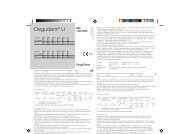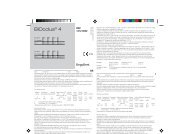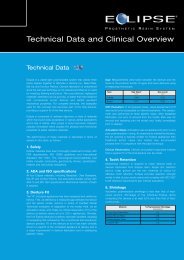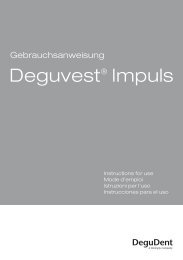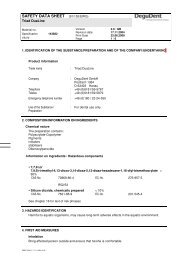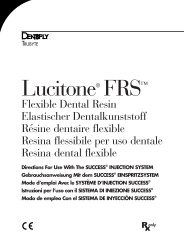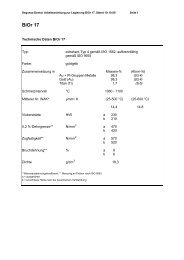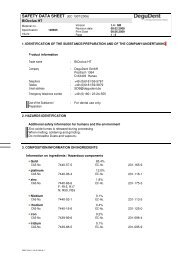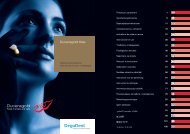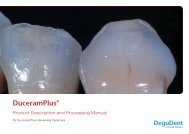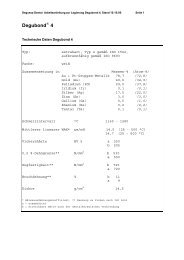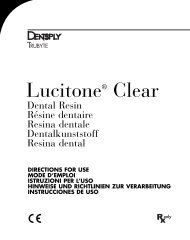BiOcclus Kiss flyer GB - DeguDent
BiOcclus Kiss flyer GB - DeguDent
BiOcclus Kiss flyer GB - DeguDent
Create successful ePaper yourself
Turn your PDF publications into a flip-book with our unique Google optimized e-Paper software.
<strong>BiOcclus</strong> ®<br />
The power of gold<br />
The high-gold Pd-Cufree<br />
alloy that follows<br />
the conventional <strong>Kiss</strong><br />
concept
The power of gold<br />
<strong>BiOcclus</strong> <strong>Kiss</strong> is a unique high-gold alloy that is a part of the <strong>Kiss</strong> concept. It represents an exciting innovation in alloy<br />
technology and is far ahead of the competition thanks to its advanced composition. <strong>DeguDent</strong> has managed to<br />
provide an alloy for the conventional <strong>Kiss</strong> concept that meets the requirements of dental technicians, dentists and<br />
patients alike. The conventional <strong>Kiss</strong> concept offers safety in ceramics and alloys thanks to exactly matched<br />
components. <strong>BiOcclus</strong> <strong>Kiss</strong> lets you create highly aesthetic and safe dental restorations even in challenging clinical<br />
baseline situations.
Yellow – Pd-Cu-free – extremely stable under heat<br />
The alloy<br />
The novel fine-grain <strong>BiOcclus</strong> alloy<br />
consists of only six different chemical<br />
elements for top-level biocompatibility.<br />
The slightly higher platinum ratio is<br />
responsible for the alloy’s remarkable<br />
stability under heat, while preserving<br />
its attractive warm yellow hue.<br />
Another advantage of this particular<br />
alloy composition is the warm color of<br />
the fired oxide, a prerequisite for<br />
beauty and aesthetics in red and<br />
white at the interface of the tooth’s<br />
hard tissues and the gingiva’s soft<br />
tissues. <strong>BiOcclus</strong> <strong>Kiss</strong> can be cast<br />
multiple times without any problems<br />
and without losing its yellow color. Its<br />
stability under heat is quite remarkable<br />
among copper- and palladiumfree<br />
alloys and therefore deserves<br />
special mention. There are no obstacles<br />
to using this alloy for any type of<br />
crowns, implant superstructures and<br />
bridges.<br />
Processing<br />
<strong>BiOcclus</strong> <strong>Kiss</strong> can be processed in<br />
any commercial casting units. When<br />
melted, this alloy produces no slag.<br />
Another highlight is its excellent polishing<br />
and milling behaviour. You will notice<br />
no difference from any palladiumbased<br />
alloy. Suitable solders and a<br />
specific laser welding wire are available<br />
for mastering connection tasks.<br />
Economical<br />
considerations<br />
Its CTE of 14.2 µm/m·K (25 – 500 °C)<br />
and 14.4 µm/m·K (25 – 600 °C) is<br />
perfectly adapted to Duceram ® <strong>Kiss</strong><br />
and requires no long-term cooling<br />
and no tempering phase. Its low oxide<br />
temperature of 900 °C (5 minutes at<br />
atmospheric pressure) means substantial<br />
time saving.<br />
Veneering<br />
Veneering with Duceram <strong>Kiss</strong> gives<br />
<strong>BiOcclus</strong> <strong>Kiss</strong> restorations natural<br />
aesthetics. The alloy’s warm yellow<br />
hue is an ideal starting point for<br />
creating natural-looking dental restorations.<br />
With only 73 different materials,<br />
Duceram <strong>Kiss</strong> is the most efficient<br />
ceramic system on the dental market.<br />
You have a choice between a<br />
standard three-layer technique and<br />
a highly individualized layering technique.<br />
The result is certain to please<br />
you. In addition, the reduction in the<br />
number of different materials makes<br />
for the superior economy of this<br />
ceramic system while not requiring<br />
a single compromise.<br />
Another highlight is the newly developed<br />
opal incisal, which remains<br />
stable under firing. It combines a<br />
natural blue/yellow effect with extreme<br />
transparency. Duceram <strong>Kiss</strong> is<br />
a ceramic system that is a perfect<br />
match for <strong>BiOcclus</strong>.
All advantages at a glance<br />
10035/0505/KH<br />
Material properties<br />
• Pd-Cu-free<br />
• Only six elements<br />
• Biocompatible<br />
• High corrosion resistance<br />
• High heat resistance<br />
• Excellent bonding between<br />
metal and ceramics<br />
• Warm-colored oxide<br />
Processing<br />
• No long-term cooling or<br />
tempering phases<br />
• Excellent polishing and milling behaviour<br />
• Oxide temperature 900 °C<br />
(5 minutes at atmospheric pressure)<br />
• Ceramic bonding with Duceram <strong>Kiss</strong><br />
Indications<br />
• Inlays, onlays, single crowns<br />
• Crowns and bridges of any<br />
physiologically appropriate span<br />
• Millable<br />
• Large connectors<br />
• Superstructures<br />
• Primary and secondary crowns<br />
• Attachments and bar-supported<br />
restorations<br />
Technical specifications<br />
Type: Extra hard pursuant to ISO 1562<br />
Color:<br />
Light yellow<br />
Composition in: Mass % Atom %<br />
Au and Pt group metals 97.7 94.3<br />
Au 81.6 78.6<br />
Pt 16.0 15.6<br />
Zn 1.4 4.1<br />
In 0.5 0.8<br />
Nb 0.4 0.8<br />
Ir 0.1 0.1<br />
Melting range (°C) 1050 – 1160<br />
Mean linear CTE* (µm/m·K) 14.2 (25 – 500 °C)<br />
14.4 (25 – 600 °C)<br />
Vickers hardness (HV5) b 220<br />
a 220<br />
0.2 % yield strength** (N/mm 2 ) b 530<br />
a 530<br />
Tensile strength** (N/mm 2 ) b 630<br />
a 640<br />
Elongation at fracture** (%) b 9<br />
a 8<br />
Density (g/cm 3 ) 19<br />
Solders<br />
before firing: Degudent ® solder G1<br />
after firing: DG 750<br />
<strong>DeguDent</strong> GmbH<br />
P.O.Box 13 64 · 63403 Hanau<br />
GERMANY<br />
www.degudent.com<br />
* Coefficient of thermal expansion<br />
** Measurements performed on samples<br />
pursuant to EN ISO 9693<br />
a = hardened 15 min/950 °C + 15 min/500 °C<br />
b = achievable hardness after ceramic veneering



